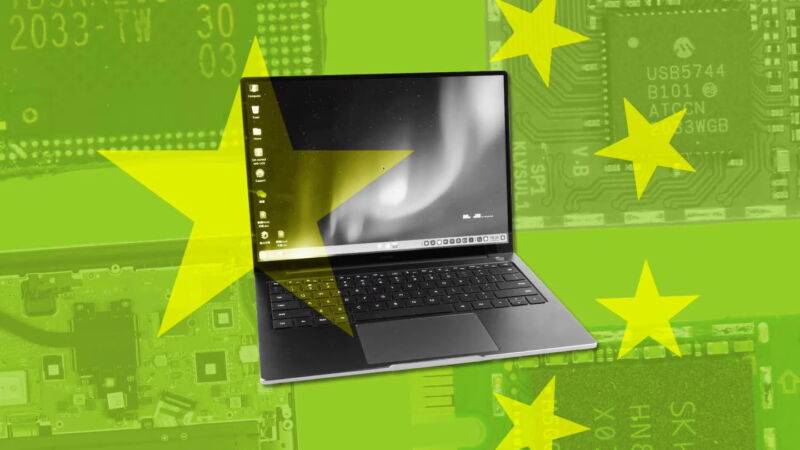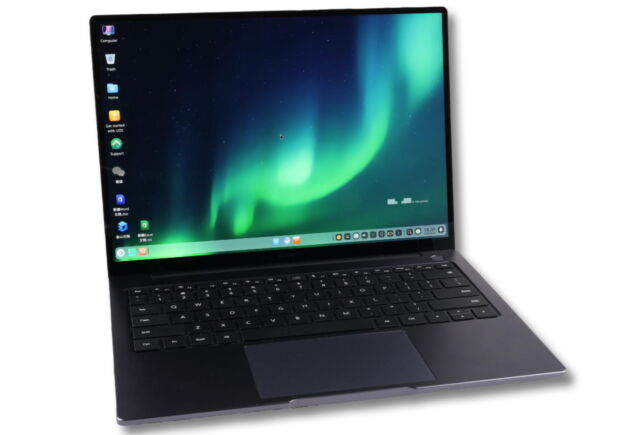
FT
China’s demand that the public sector step up use of domestic semiconductors can best be seen within Huawei’s Qingyun L540 laptop.
The “safe and reliable” device features a self-designed processor and a Chinese-made operating system, having stripped out foreign-made components and software as much as possible.
The computer, which is being snapped up by governments and state groups across the country, has become the signature model of China’s localization campaign known as Xinchuang, or “IT application innovation.”
For decades, Chinese officials have dreamt of creating a domestic tech supply chain, especially in building-block components like semiconductors. Progress was slow. But Washington’s ratcheting embargo on high-tech goods has spurred Beijing to redouble its efforts.
“We must ramp up R&D efforts in semiconductors, machine tools, and foundational software,” President Xi Jinping exhorted top scientists and policymakers this summer. “They provide the technological backbone for independent, secure, and controllable supply chains,” he said.
Chinese officials are now combining the heft of state spending and financial support with top-down directives to buy local tech, particularly in semiconductors.
Late last year state buyers were directed to phase out computers powered by American processors.
Since implementing the directive in March, central agencies have transitioned from exclusively purchasing laptops running on Intel and AMD processors last year to now acquiring three-quarters of their devices with chips from Chinese companies like Huawei, Shanghai Zhaoxin, and Phytium, according to public records. Huawei’s Qingyun L540 has won a majority of the orders.
Inside Huawei’s localized laptop

FT
TechInsights looks at five elements within the laptop’s motherboard.
-
Many are purchasing Huawei’s Qingyun L540, which research group TechInsights has helped the FT pull apart.
FT/TechInsights -
1. Processor: The laptop’s HiSilicon 9006C processor sits underneath the SK Hynix RAM chip. It was made during the week of August 10, 2020, in Taiwan on TSMC’s 5 nanometer node, and Huawei stockpiled a large number of the chips ahead of US sanctions.
FT/TechInsights -
2. SSD card. The 512GB SSD Card was made by SK Hynix during the week of December 14, 2020, possibly at the South Korean group’s plant in China, according to TechInsights. The packaging date is after the date US sanctions were supposed to cut off supplies to Huawei.
FT/TechInsights -
3. Wi-Fi/Bluetooth. Another Huawei HiSilicon chip powers the laptop’s Wi-Fi and Bluetooth functions.
FT/TechInsights -
4. Audio amplifiers. The audio amplifier chips help the laptop play sound and come from Chinese company Goodix. The Shenzhen-based company is taking market share from Texas Instruments and Analog Devices.
FT/TechInsights -
5. USB controller. USB Controller chip from US company Microchip manages communication between the processor and devices connected via USB ports.
FT/TechInsights
What kicked off as a campaign to cut foreign tech products out of the offices of governments and state-owned groups has gradually expanded into a wider array of products.
Automakers, including major European groups that produce cars in joint ventures with Chinese state-owned firms, have been directed to step up their use of domestic semiconductors, according to four people familiar with the matter.
Two of the people said they had been given a target to use Chinese chips for 25 percent of the total by next year, though there were not yet consequences for failing to do so. Nikkei Asia previously reported this directive.
China’s Ministry of Industry and Information Technology, which is leading the country’s tech localization efforts, has outlined a plan for national auto chip standards. The goal is to “provide space for our country’s indigenous innovation in auto chips,” MIIT said in December.
An engineer at a major European vehicle maker said they have begun to inventory their components and where their chips came from. “It will not be easy to design-in Chinese chips,” the person said. “But if we are able to do so successfully, I expect they will be pushed into global products because they are so much cheaper.”
Major foreign telecom kit makers are also being encouraged to substitute domestic semiconductors into their gear to maintain sales, two people familiar with the matter said.
State-backed China Telecom recently tendered for 150,000 servers for its network. Two-thirds of the order was reserved for servers equipped with domestic processors, procurement records show.
Huawei’s Qingyun laptop, tested by the FT, also contains Chinese software running on the local hardware. The device ran on the Chinese-made Unity Operating System, based on Linux. Users can play music, edit photos, or create Word documents and spreadsheets, similar to a Windows machine. But all of the applications are made in China.
